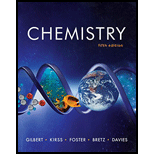
Concept explainers
(a)
Interpretation: The information regarding the treatment of a patient by BNCT technique that includes treating him with a compound that contains 10B that gets accumulated inside cancer tumors and then the further irradiation with neutrons that are absorbed by 10B nuclei and the formation of unstable form of 11B undergoing alpha decay to 7Li is given. Various questions based on the radioactivity involved in this treatment have to be answered.
Concept introduction: The emission of radiation by unstable nuclei in the form of alpha, beta particles with a neutrino is called a radioactive decay.
To determine: The balanced equation for the neutron absorption by 10B and further alpha decay process.
(a)
Answer to Problem 19.69QP
Solution
The overall equation is given as,
105B+10n→73Li+42He
Explanation of Solution
Explanation
The equation representing the absorption of neutron by 10B is given as,
105B+10n→115B
The equation for the alpha decay in 11B is given as,
115B→73Li+42He
The overall equation is given as,
105B+10n→73Li+42He
(b)
To determine: The energy released by each nucleus of Boron −10 in the obtained reaction.
(b)
Answer to Problem 19.69QP
Solution
The energy released by each nucleus of Boron −10 is -4.42×10-13 J_.
Explanation of Solution
Explanation
Given
The mass of 10B is 10.0129 amu.
The mass of 1n is 1.00866 amu.
The mass of 7Li is 7.01600 amu.
The mass of 4He is 4.00260 amu.
The reaction is,
105B+10n→73Li+42He
The formula for the amount of energy released during fusion is given as,
ΔE=Δmc2 (1)
Where,
- Δm is the change in the mass.
-
c is the
speed of the light (3.0×108 m/s).
The change in the mass is calculated as,
Δm=Mass of products−Mass of reactants
Substitute the mass of reactants and products in the above equation as,
Δm=Mass of products−Mass of reactants=(7.01600 amu+4.00260 amu)−(10.0129 amu+1.00866 amu)=11.0186 amu−11.02156 amu=−0.00296 amu
The conversion of amu into kg is done as,
1 amu=1.66054×10−27 kg
Hence, the conversion of −0.00296 amu into kg is done as,
−0.00296 amu=−0.00296×1.66054×10−27 kg=−0.0049151984×10−27 kg
Substitute the value of Δm and c in the equation (1),
ΔE=Δmc2=−0.0049151984×10−27 kg×(3×108 m/s)2=−4.42×10−13 kg m2s−2
The conversion of kg m2s−2 to J is done as,
1 kg m2s−2=1 J
Hence, the conversion of −4.42×10−13 kg m2s−2 to J is done as,
−4.42×10−13 kg m2s−2=−4.42×10−13×1 J=-4.42×10-13 J_
Therefore, energy released by each nucleus of Boron −10 is -4.42×10-13 J_.
(c)
To determine: The reason behind the effective use of nuclide that undergoes alpha decay in the cancer therapy.
(c)
Answer to Problem 19.69QP
Solution
The negligible penetration of particles showing alpha decay inside the healthy tissue and high RBE value are the reasons for the use of nuclide that undergoes alpha decay is effective in cancer therapy.
Explanation of Solution
Explanation
The nuclide that undergoes alpha decay is effective in cancer therapy because they have a high value of RBE and the second reason is that if a radionuclide is placed is placed inside a tumor then these alpha particles do not show any penetration into the healthy tissue.
Conclusion
- a. The overall equation is given as,
105B+10n→73Li+42He
- b. The energy released by each nucleus of Boron −10 is -4.42×10-13 J_.
- c. The negligible penetration of particles showing alpha decay inside the healthy tissue and high RBE value are the reasons for the use of nuclide that undergoes alpha decay is effective in cancer therapy
Want to see more full solutions like this?
Chapter 19 Solutions
Chemistry: The Science in Context (Fifth Edition)
- Identify the compound with the longest carbon - nitrogen bond. O CH3CH2CH=NH O CH3CH2NH2 CH3CH2C=N CH3CH=NCH 3 The length of all the carbon-nitrogen bonds are the samearrow_forwardIdentify any polar covalent bonds in epichlorohydrin with S+ and 8- symbols in the appropriate locations. Choose the correct answer below. Η H's+ 6Η Η Η Η Η Ηδ Η Ο Ο HH +Η Η +Η Η Η -8+ CIarrow_forwardH H:O::::H H H HH H::O:D:D:H HH HH H:O:D:D:H .. HH H:O:D:D:H H H Select the correct Lewis dot structure for the following compound: CH3CH2OHarrow_forward
- Rank the following compounds in order of decreasing boiling point. ннннн -С-С-Н . н-с- ННННН H ΗΤΗ НННН TTTĪ н-с-с-с-с-о-н НННН НН C' Н н-с-с-с-с-н НН || Ш НННН H-C-C-C-C-N-H ННННН IVarrow_forwardRank the following compounds in order of decreasing dipole moment. |>||>||| ||>|||>| |>|||>|| |||>||>| O ||>>||| H F H F H c=c || H c=c F F IIIarrow_forwardchoose the description that best describes the geometry for the following charged species ch3-arrow_forward
- Why isn't the ketone in this compound converted to an acetal or hemiacetal by the alcohol and acid?arrow_forwardWhat is the approximate bond angle around the nitrogen atom? HNH H Harrow_forwardOH 1. NaOCH2CH3 Q 2. CH3CH2Br (1 equiv) H3O+ Select to Draw 1. NaOCH2 CH3 2. CH3Br (1 equiv) heat Select to Edit Select to Drawarrow_forward
- Complete and balance the following half-reaction in acidic solution. Be sure to include the proper phases for all species within the reaction. S₂O₃²⁻(aq) → S₄O₆²⁻(aq)arrow_forwardQ Select to Edit NH3 (CH3)2CHCI (1 equiv) AICI 3 Select to Draw cat. H2SO4 SO3 (1 equiv) HO SOCl2 pyridine Select to Edit >arrow_forwardComplete and balance the following half-reaction in basic solution. Be sure to include the proper phases for all species within the reaction. Zn(s) → Zn(OH)₄²⁻(aq)arrow_forward
 ChemistryChemistryISBN:9781305957404Author:Steven S. Zumdahl, Susan A. Zumdahl, Donald J. DeCostePublisher:Cengage Learning
ChemistryChemistryISBN:9781305957404Author:Steven S. Zumdahl, Susan A. Zumdahl, Donald J. DeCostePublisher:Cengage Learning ChemistryChemistryISBN:9781259911156Author:Raymond Chang Dr., Jason Overby ProfessorPublisher:McGraw-Hill Education
ChemistryChemistryISBN:9781259911156Author:Raymond Chang Dr., Jason Overby ProfessorPublisher:McGraw-Hill Education Principles of Instrumental AnalysisChemistryISBN:9781305577213Author:Douglas A. Skoog, F. James Holler, Stanley R. CrouchPublisher:Cengage Learning
Principles of Instrumental AnalysisChemistryISBN:9781305577213Author:Douglas A. Skoog, F. James Holler, Stanley R. CrouchPublisher:Cengage Learning Organic ChemistryChemistryISBN:9780078021558Author:Janice Gorzynski Smith Dr.Publisher:McGraw-Hill Education
Organic ChemistryChemistryISBN:9780078021558Author:Janice Gorzynski Smith Dr.Publisher:McGraw-Hill Education Chemistry: Principles and ReactionsChemistryISBN:9781305079373Author:William L. Masterton, Cecile N. HurleyPublisher:Cengage Learning
Chemistry: Principles and ReactionsChemistryISBN:9781305079373Author:William L. Masterton, Cecile N. HurleyPublisher:Cengage Learning Elementary Principles of Chemical Processes, Bind...ChemistryISBN:9781118431221Author:Richard M. Felder, Ronald W. Rousseau, Lisa G. BullardPublisher:WILEY
Elementary Principles of Chemical Processes, Bind...ChemistryISBN:9781118431221Author:Richard M. Felder, Ronald W. Rousseau, Lisa G. BullardPublisher:WILEY





